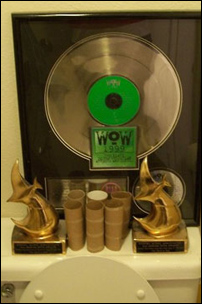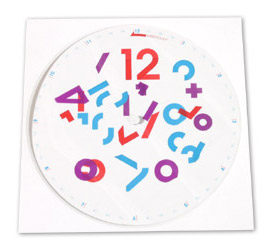Year: 2005
Coded clue to text adventure bot hidden in Google’s new Talk client.
Watch out, infocombot
Valentine Hellman checked in today with easily the best email I’ve received in a long time. Valentine, you see, OWNS a platinum record. He’s taken it upon himself to play it and determine what exactly the grooves of a default platinum record contain.
Clearly, this is awesome. Here’s his email:
“I have a story I thought you might be interested in. Long story short is that I used to be in a cheesy Christian band, and we had a single that was on a double-CD compilation. This comp sold 250,000 copies and since it contained two CDs the RIAA certified it platinum. I have possessed a platinum record for the past six or seven years. I had it hanging over the toilet in my bathroom. Anyways, last Saturday my friends and I busted it out of the frame and put it on a turntable.
You might be interested to know these facts about the record:
- The hole in the middle was the size of the hole in the middle of a CD.
- There is extra space around the outside of the record that gets covered by the matting which makes it larger than a standard 12″ LP.
- There is only information on one side of the “record.”
- The thing is extremely thin as well. Like tin can thin. Thinner even.
- The strangest thing is that when I played it, everything was backwards. I ended up spinning it backwards to hear the recording.
Anyways, the record always looked like it only had two tracks, and it turns out it did. The tracks were not what the same as the ones that are on the compilation record. After some research I think that the tracks are from a Salsoul Orchestra 12″ single. I don’t know who they are, but I downloaded a snippet of one of their songs from the single and I think it is a match. One of my friends taped the whole experience and hopefully I will post this somewhere if you are ever interested.
Here is my full write up if you are interested, which is also where I will eventually let people know where to find the video footage.”

There’s more backstory at the link. Hooray for Mr. Hellman’s inquisitive nature — we now have EVEN MORE useless vinyl-related knowledge!
Tiny Update:
Many people have suggested that this item was in fact a factory mold, not a record. This would explain why it played in reverse. Since audio information on vinyl is represented by lateral variation in the groove (Not vertical, as I thought until very recently), it’s entirely possible that playing a factory mold would yield the results described. This, of course, begs the question, are all platinum records made from discarded factory molds? One way to find out would be to play another one…
Great arcade ‘Coin Reject’ T-shirt.
I have a feeling I’d be getting poked in the chest too much if I wore this.
Ever since Readymade Magazine got my brain churning on the possibilities of DIY clocks, I’d been toying with the idea of having the minute and hour hands rotate entire transparent clock faces — to create some sort of evolving image. That’s as far as I ever got with the idea, so I was pretty excited to see that someone else has effectively finished the thought.
The face of the Imbroglio clock consists of a soup of multi-colored shapes on transparent backgrounds, which rotate and convene hourly in such a way that the numerical representation of the hour is visible, however briefly. Definitely not the most functional clock, but endlessly appealing to my nerdy sensibilities. If it weren’t $120, I would be all over that shit.

Anyway, the point of all this is to put this thought out there so that other internet wanderers might stumble across it and inform me of similarly evolving clock faces. That’s all. [via]
Update:
This ‘bingo’ watch similarly plays with the idea of a rotating, semi-transparent clock face; and this binary clock implementation uses semi-transparent faces as well. The ‘Decider‘ watch also uses a face with transparent areas.
Even more examples: The insanely expensive ‘Opus 8’ wristwatch uses a face with extended pins that push up segments to create a pretty sweet analog / digital marriage. Nadine Grenier, a student at ESAD Strasbourg, made a kinetic installation consisting of 500 clockworks, the hands of which line up every 12 hours to form a sentence in french, which roughly translates to ‘Time passes, and every time the time passes, there is something that fades.’ Similarly, Christiaan Postma has designed a clock that uses dozens of synchronized hands to spell the current hour. Finally, an as yet unproduced prototype for a clock with a single hand, perpendicular to the plane of the face. The hour, minute, and second hands are created in shadow via three rotating lamps.
Aw, hell, why not more: Clock faces that rotate to form a digital representation of the time (And again, as a product from Art Lebadev; and again, as a gallery show, and another), a clock face that self-destructs over the period of 100 years, a clock face with each hand’s center point attached to the end point of the previous hand, an LCD video screen-as-clock-face that shows the hands being redrawn, a clock face that rotates as one piece, using gravity and a ball to mark time, and a clock face designed to be used as a scheduling whiteboard, with an eraser-equipped hour hand.
– crazy mosaic-esque images made from falling drops of water.
Literary historical investigation:
did Ralph Waldo Emerson decapitate his wife becaise he thought she was a vampire?